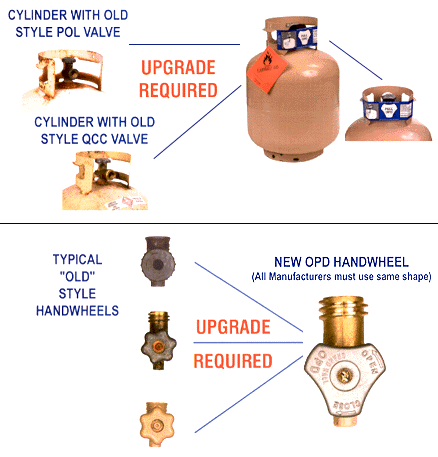Serving the
Contractor, Landscaper and Homeowner
Since 1972
"Our Service Is The Difference"

|
![]()
![]()
![]()
![]()
| Back to Propane Main Page |
What You Need to Know about OPD Cylinders
Effective April 1, 2002 by law, all tanks must be equipped with an OPD device
- As of April 1,
2002, OPDs are required on all propane cylinders between 4 and 40 pounds
propane capacity, per the 1998 edition of NFPA 58, Liquefied Petroleum
Gas Code. Cylinders of this size manufactured after September 30,
1998, were

required to have an OPD. A typical gas grill cylinder holds about 20 pounds of propane.
- Propane cylinders with OPDs can be identified by a triangular hand-wheel (pictured right). Some earlier model cylinders were produced with a round hand-wheel but "OPD" is stamped on the brass valve body.
- After April 1, 2002, propane cylinders not equipped with an OPD must be retrofitted with the device before refilling can occur or properly disposed of and replaced with an OPD-equipped cylinder.
- Many propane dealers will retrofit older cylinders with an OPD. As there is a charge for this, it may be more economical to replace the entire cylinder, especially if it is rusty. In many parts of the U.S., exchange cylinder racks can be used to swap an empty cylinder without an OPD for a full cylinder equipped with an OPD, for a nominal fee, eliminating the need to dispose of the cylinder or to have it retrofitted.
- Dispose of propane cylinders safely. Questions about safe disposal should be answered by local fire departments, hazardous waste collection sites, or propane refillers.
-
The 2001 edition of NFPA 58 modified requirements to exempt horizontal cylinders manufactured before October 1, 1998, from requiring OPDs. Also exempt are cylinders used for industrial trucks, industrial welding and cutting gases (these cylinders must be labeled with their use).
Please do not ask us to refill a non-conforming cylinder, it is illegal for us to do so.


